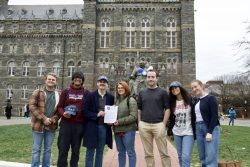I’m sitting in a Starbucks thumbing through a World Bank report on education. My cold, numb hands clasp a coffee cup for warmth.
“64 million primary and 72 million lower secondary school children in lower-income countries are not in school.” In the margins I scrawl “by the time we figure out the next moves, we’ll have missed their generation, prob. the next one.”
I’m used to these statistics. I’ve studied global development at Georgetown for almost four years now, oscillating from hopeful to hopeless and back around again. Coming into my freshman year, I was glum and skeptical after spending time on the ground in Kenya during my gap year. Months of frustrating work in a USAID clinic, where I was given a 30-minute introduction into HIV/AIDS testing and follow-up counseling. This by a 40-year-old man who asked me to get a beer at minute 32—and shut down the clinic early. Days where I tried to write engaging lesson plans (using 20-year-old textbooks) for my students, arguing with the headmaster against rote memorization, only to have half my class not show up.
Money squandered, initiatives thrown aside, not taken seriously as an unmarried, childless 18 year old, I returned to the U.S. disenchanted to say the least. I was convinced that the way the international community was practicing development was broken, and I was sure I’d have nothing to do with it. This sense left me adrift. Little did I know that I’d be spending my next few years on the Hilltop and in Washington learning about development from all different angles, and trying to access the best way forward.
On this freezing Monday morning in downtown D.C., this case study about a plan to increase literacy among rural girls in Pakistan by connecting them to teachers through the use of cell phones is yet another foray into a development model. Crinkling my brow, contemplating cost-efficiency and reach, capacity to scale, and impact, I sip my coffee.
“Over 32% of children in Pakistan are out of school. Over two-thirds of girls in Pakistan don’t attend school…”
Numb to the numbers.
When you hear numbers like these daily, any sense of sentimental attachment to an individual represented by such statistics slips away. I have practiced, with each report and economic model, flexing my mental muscles to examine the cost-benefit analysis of each policy. I’ve become a much better practitioner as I’ve toned these muscles, gaining a vital skill set. But as the young girl who cried when I learned about the Darfur Genocide in middle school and loaded my bag up in high school with packed snack bags to give out to people living on the streets, I had to train the strongest muscle in my body—the one Hallmark morphed into a simplistic shape and pasted all over valentines, the one that’s meant to ooze empathy and emotion—to quiet down. In the cold reality of development, this is practical and necessary.
I flip the report back to the front page—predictably, there is a group of smiling kids in some developing country on the cover. I sigh and look up. I’m sitting across from the World Bank, where this report came from. The International Monetary Fund is adjacent. Large, sleek glass buildings.
The Starbuck’s solid door opens with a gust of wind and a thin grey raincoat comes in, a man huddled into himself below it. Freezing. Emanating, encompassing, embodying. Freezing. A black man in his 50s, with a Nike backpack, he is dressed immaculately, in very clean, threadbare clothes. As he sits down, he does so in a manner that is not quite collapsing, but gives the sense that all of his energy has been released as he sinks—straight-backed—into a cushioned seat. It happens to be the seat farthest from the counter, directly across from me.
I realize then I have been looking at him, and that I haven’t looked away since he walked in. Perhaps it has been seconds or minutes, but it might be obvious I’ve been staring, so I blink my eyes away to the wall. I count to five and then look back, a little more discreetly this time.
His backpack fell to the floor as he sank to the seat, resting horizontally beside him. He had pushed off his gloves, and they too had fallen onto the backpack. He is breathing heavily, wheezing, staring out the window—seeing nothing, no one. Slowly and subtly trying to remain inside that Starbucks and soak in some warmth.
It’s his eyes that give him away. It’s his eyes that I can’t stop looking at. They are wet, as if leaking but not spilling. Transfixed somewhere beyond the Starbucks, far beyond those inside of it. They seem both overlarge and bulging, and also slightly sunken. At first I thought they were just elsewhere. But now, I realize they are desperate eyes. Bone-deep tired eyes.
I am jolted by the buzz of a phone on the table beside me. I look at the education report in front of me. The idea of reading it seems horribly, sickeningly laughable.
Numbers. Ideas. Far away, million-dollar projects that will end in 2022. While here is a person in front of me who I could reach out to, to whom I could offer assistance. Couldn’t I?
I freeze. How do I do it? The dilemma: to give money or food? But to do so without offending? (Is offending my own issue though, unrelated to him?) (Am I making this all up in my mind?) I should just get up and ask, start by talking. Yes, yes.
But then, before I’ve settled my internal deliberations, he stands up, bag in hand, and in one motion is gone.
I watch out the window as he walks away.
I realize I am heartbroken and stunned.
I look down blurrily at my readings.
“Many children enroll in school but drop out before completing a full cycle of primary education…”
I look up as the door opens once more to a flurry of wind. A man in an orange coat had pushed it open. A black man in his 40s, with wild hair, and disheveled clothing with a backpack on. He steps in and seems to sip up the warmth as one would sip a cup of coffee, before bee-lining for the bathroom. He clearly knows exactly where the bathroom is in this Starbucks on 18th & H.
And now, it’s my turn to leave, and oddly I am numb to the cold.
But as I turn the corner, I roll the number “64 million” over on my tongue. Kids who aren’t getting an education. 64 million. Those men could be in a similar set of statistics. Overwhelmingly large numbers that are made up of real people. Numbers with real lives in the balance. How do I hold this feeling of heartbreak in my chest when I read statistics? How do I retain my sense of the personal, of those vacant eyes in a Starbucks, as I finish this report?
Whatever the answer, I am cold again out in the world, but not so numb.





